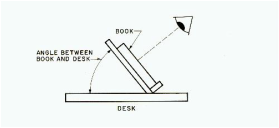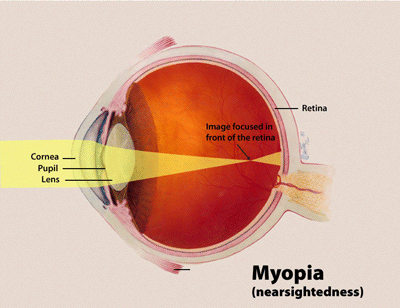Simple ways to slow down nearsighted progression?

While common, nearsightedness (myopia) has become even more prevalent around the world in recent years and presents a growing global health and economic concern. Severe nearsightedness is a major cause of visual impairment and is associated with greater risk of retinal detachment, myopic macular degeneration, premature cataracts and glaucoma. In the United States, nearsightedness now affects roughly 42 percent of the population. Developed Asian countries report increasing myopia rates of up to 80 percent, the rapid growth rate of which suggests that environmental factors play a significant role. Environmental factors that have been linked to myopia include near work such as reading or using a computer, outdoor activity, living in urban versus rural areas and education (AAO June 26, 2014).
There have been several proposed treatment options for slowing down myopia. The more recognized options are (1) speciality gas permeable orthokeratology contact lenses, (2) progressive-type corrective lenses, (3) pharmacological eye drops and (4) improving near-work habits. Here, we will primarily focus #4, proper close-up habits.
Constant and excessive near work have been shown to contribute to the progression of myopia. We can either (1) give up all reading and close work, at least until adulthood, or (2) modify the way we read in such a manner that the eyes can remain more relaxed and focused for distance. Since the first alternative is hardly practical, we have to pay attention to how we use our eyes up close. Below are some suggestions that can potentially delay the onset of myopia and/or slow down its progression.
Remember that while the proper close-work habits described above are beneficial, they are seldom sufficient to prevent or halt myopia in children who have the tendency to develop it. The amount of close work done by children in our modern society is just too much to be counteracted by the above measures alone. But the above suggestions are simple ways to at least minimize the risk of nearsighted progression.
*The above suggestions were taken from Myopia.org
There have been several proposed treatment options for slowing down myopia. The more recognized options are (1) speciality gas permeable orthokeratology contact lenses, (2) progressive-type corrective lenses, (3) pharmacological eye drops and (4) improving near-work habits. Here, we will primarily focus #4, proper close-up habits.
Constant and excessive near work have been shown to contribute to the progression of myopia. We can either (1) give up all reading and close work, at least until adulthood, or (2) modify the way we read in such a manner that the eyes can remain more relaxed and focused for distance. Since the first alternative is hardly practical, we have to pay attention to how we use our eyes up close. Below are some suggestions that can potentially delay the onset of myopia and/or slow down its progression.
- Reading Distance. The book or other material should be held as far from the eyes as possible. The distance from the elbow to the knuckles of the hand has been suggested as the minimum working distance. If the book can he propped up beyond arm's reach and read in this manner, this is even better. When reading, the child should look up and into the distance momentarily at the end of each paragraph, or at least at the end of each page, to relax the eyes. Ideally, the chair should be placed to enable looking out a window or across the room when looking up.
If a book is lying on the desk in front of a child, the top of the book is obviously further from the eyes than the bottom of the book. This means that as the child reads down the page an increasing amount of accommodation will be required. If the book is lying flat on the table, as much as 3 D more of accommodation will be needed to read the bottom of the page than is needed to read the top. It is better to support the book on a slant board so that the pages are more perpendicular to the line of sight and the bottom of the book is farther away (See figure). The angle between table and book should be fifty or sixty degrees. It is possible to make or buy an elevating desk with a surface that can be raised to various angles and locked in position for this purpose.
- Posture. Reading should not be permitted while a child is lying on the floor or lying in bed. This usually places the eyes too close to the reading material. The elbows should not be rested on the desk or table when reading or writing since this creates a posture which usually causes the head to bend forward too close to the work. A child who habitually reads while lying on the left side will probably develop more myopia in the left eye than in the right eye, because the left eye is closer to the book. If the right side is used, the right eye will probably develop more myopia.
- Lighting. Good lighting is extremely important in myopia prevention. Use as much light as possible when reading, as long as it does not cause glare or discomfort. Most people tend to use far too little light for their close work. Ceiling lighting is usually insufficient. Get a desk lamp that can be adjusted for different positions so that it can be placed to shine as much light as possible on the book. If the lamp is of the incandescent type, choose a bulb with as high a wattage as the lamp manufacturer permits without danger of overheating the lamp. Our eyes were meant to be used in daylight, so we should sit by a window or outdoors in the sunlight to read whenever possible. It is rare to find indoor illumination that comes anywhere near approaching the intensify of natural sunlight. Good lighting causes the pupil of the eye to become smaller, requiring less accommodation. In addition, good lighting eliminates the need to hold the book close.
Remember that while the proper close-work habits described above are beneficial, they are seldom sufficient to prevent or halt myopia in children who have the tendency to develop it. The amount of close work done by children in our modern society is just too much to be counteracted by the above measures alone. But the above suggestions are simple ways to at least minimize the risk of nearsighted progression.
*The above suggestions were taken from Myopia.org
